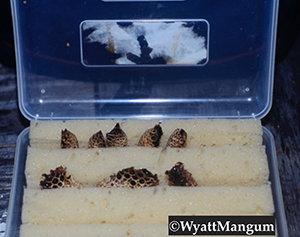
In the previous article, we learned some basic queen cell biology, which gives an indication of the developing queen bee’s environment, and her potential to support a colony with enough eggs. We learned how to judge good queen cells from poorly attended ones. From the former, we should obtain better queen bees. With the goal of moving queen cells from donor colonies to recipient colonies, we took the step of learning how to cut queen cells from the combs.
After removal from the donor colonies, let’s assume the queen cells must be transported to another apiary. Even for beekeepers with all their hives in the home location, this device should still be of interest to hold queen cells safely.
Obviously, queen cells can be damaged by temperature fluctuations and physical shocks. Therefore queen cells should be kept out of the hive no longer than necessary and handled gently. Newly sealed queen cells, the larvae still feeding, seem to be more vulnerable to temperature drops and even minor bumps compared to ripe queen cells. When the bees have partially exposed the queen’s cocoon (shown in the previous article), I feel it is relatively safe to transport the queen cell.
I have carried queen cells in various containers over the years. Once I had a little wooden box with a thick floor. Holes were cut in the floor to receive the queen cells. The wooden box worked well, but it did not pad the queen cells very well against vibrations, even though I let it ride on the front seat of the bee truck between apiaries. I even held the queen-cell box when driving over moon-cratered dirt roads so the cells would weather the gut-wrenching drop that felt like driving over the shallow-end of a swimming pool. At tractor speed, I steered and shifted gears one-handed, in order to protect the developing queens.
Now I have a queen-cell carrying box, which is easy to construct. It is a translucent plastic box, fitted with a piece of foam padding, the springy kind from shipping boxes (see Figure 1). Using a queen cell as a guide for size, I cut a couple of grooves in the foam. I want the foam grooves to securely “hug” queen cells placed in them (see Figure 2).
On a chilly spring day in weak sunlight, the translucent plastic should help warm the inside of the box. (Never put the box in direct sunlight. The queen cells could overheat.) The translucent plastic lets me see into the box. I have had numerous queens emerge in the box. More than once during a busy spring, I have had to pull the bee truck off the highway to break up queen fights and jail combatants in my queen cages. Yes, it’s like a little raucous Saturday night, right on my front seat, while I try not to change from the Sheriff to Coroner.
On a long trip to another apiary, roughly more than 20 minutes, I aim a heater vent at the closed queen-cell box on the truck seat. The queen-cell box warms and cools quickly, which is either an advantage or a disadvantage depending on the circumstances. The queen-cell box stays on board of the bee truck all year to make sure I have it when needed.
After arrival at the recipient colony, the queen cell must be attached to one of its brood combs. The exact queen-cell location is extremely critical. First, the place on the comb needs to be a little larger than the queen cell. The location must have a lot of bee activity. Remember, the queen cell must be kept at brood rearing temperature (95ºF, 35ºC) for proper completion of the queen’s development. Typically, a central area of the brood comb is fine for the temperature.
To make space for the queen cell and to secure it to the comb, the brood cells at the exact receiving spot need to be crushed to form a depression in the comb a little larger than the queen cell. Here, a difficulty can occur because in high bee-traffic areas of the brood nest, the cells are typically loaded with something that will turn to a liquid upon squashing the cells. Cells with young pupae (appearing as capped brood) and older larvae are numerous in a brood nest. All of that must be avoided for making the queen-cell depression. With the liquid contents from these crushed cells contaminating the comb depression, the wax from each (comb and queen cell) will not stick together.
When finding a patch of empty brood cells is difficult in a tightly filled brood nest, I recommend looking for a patch of eggs or very young larvae (where the cells barely glisten). These cells are essentially empty, and from them a ….


